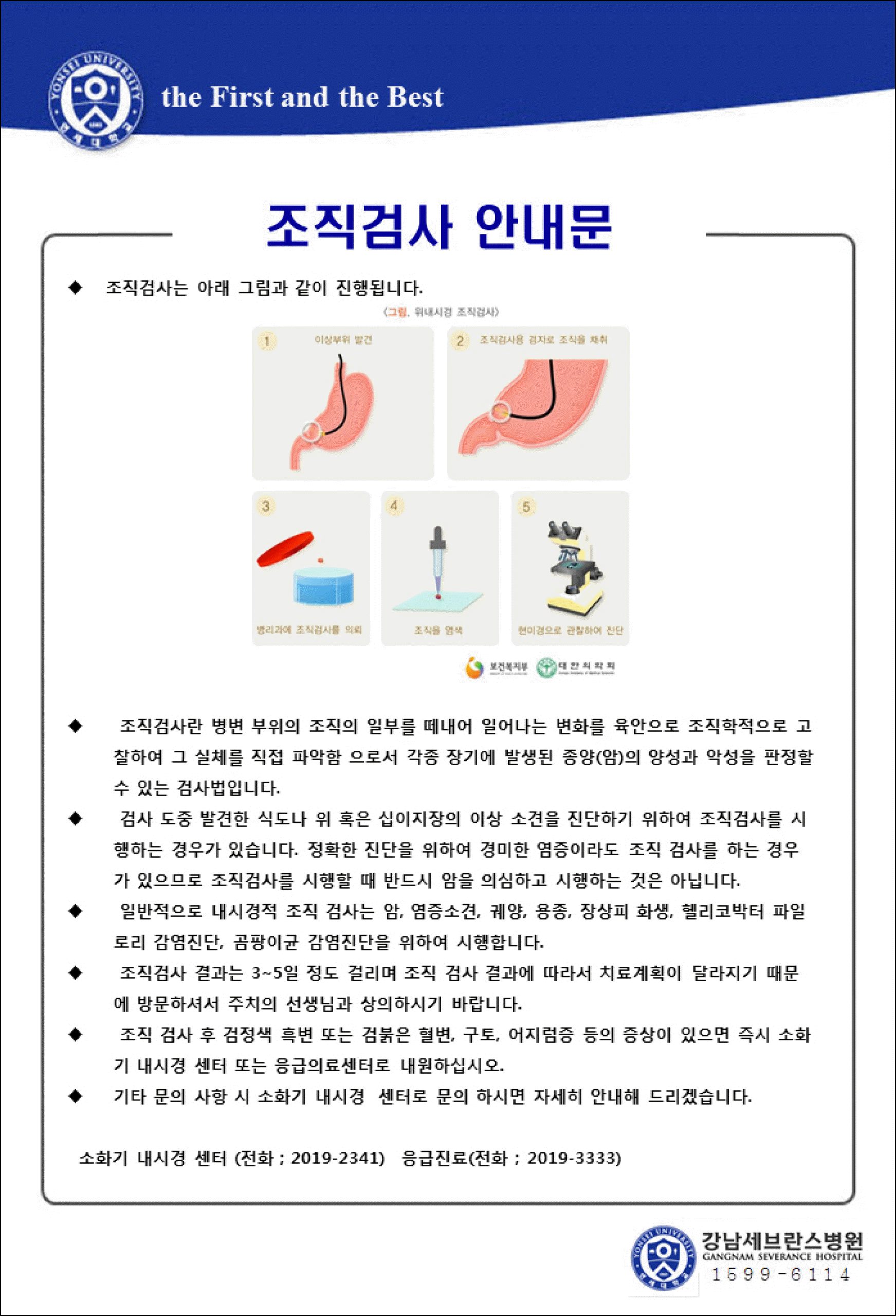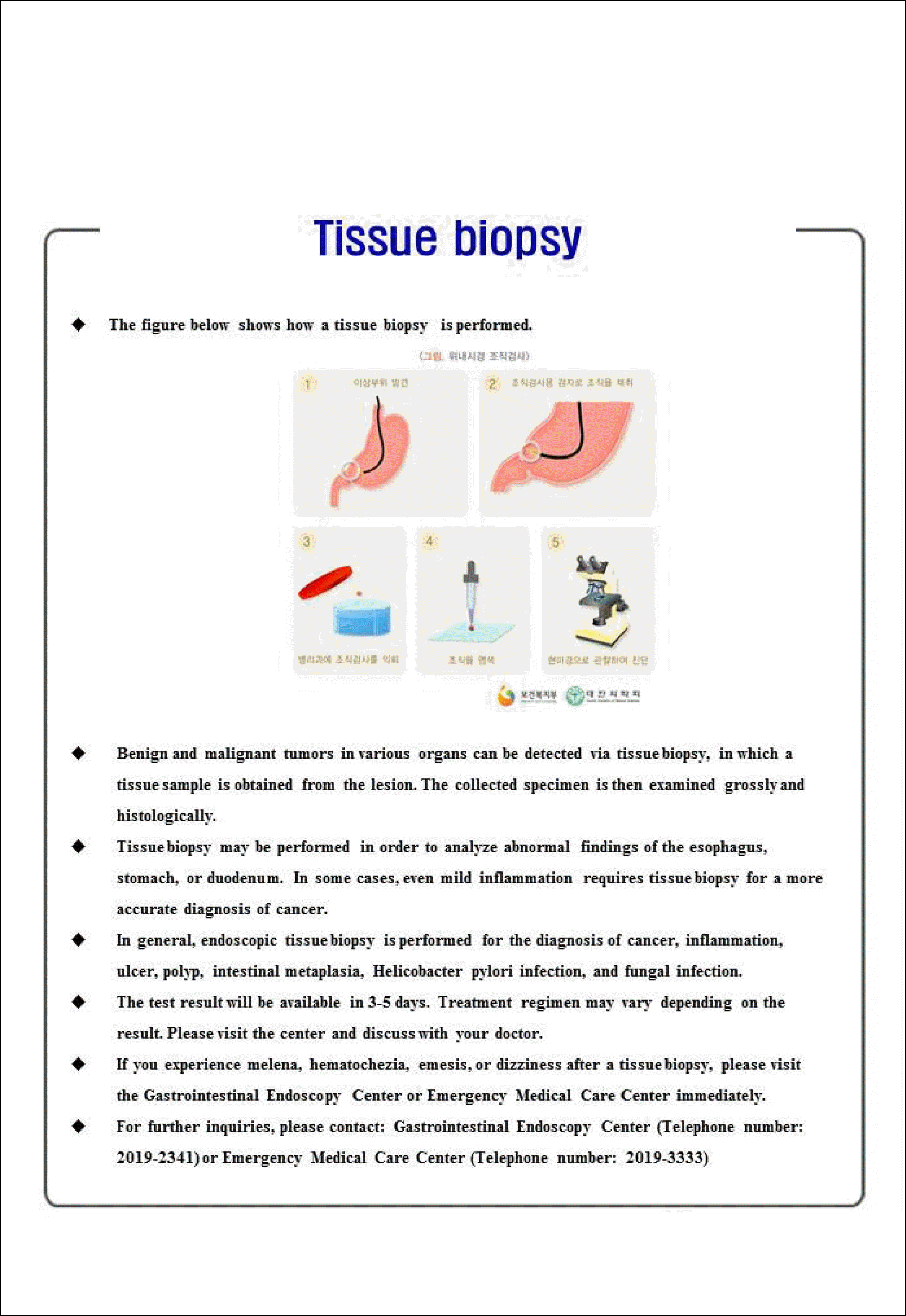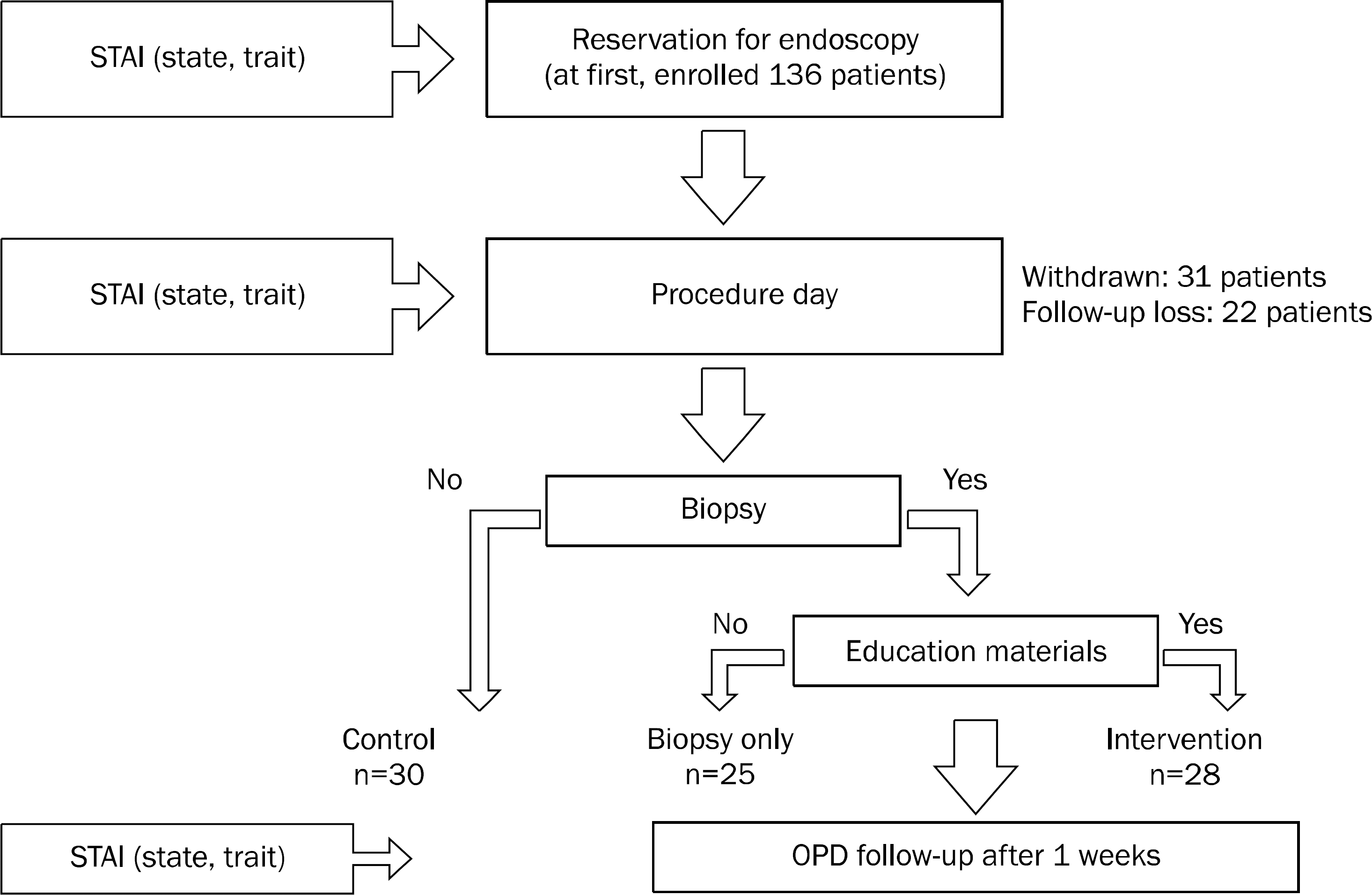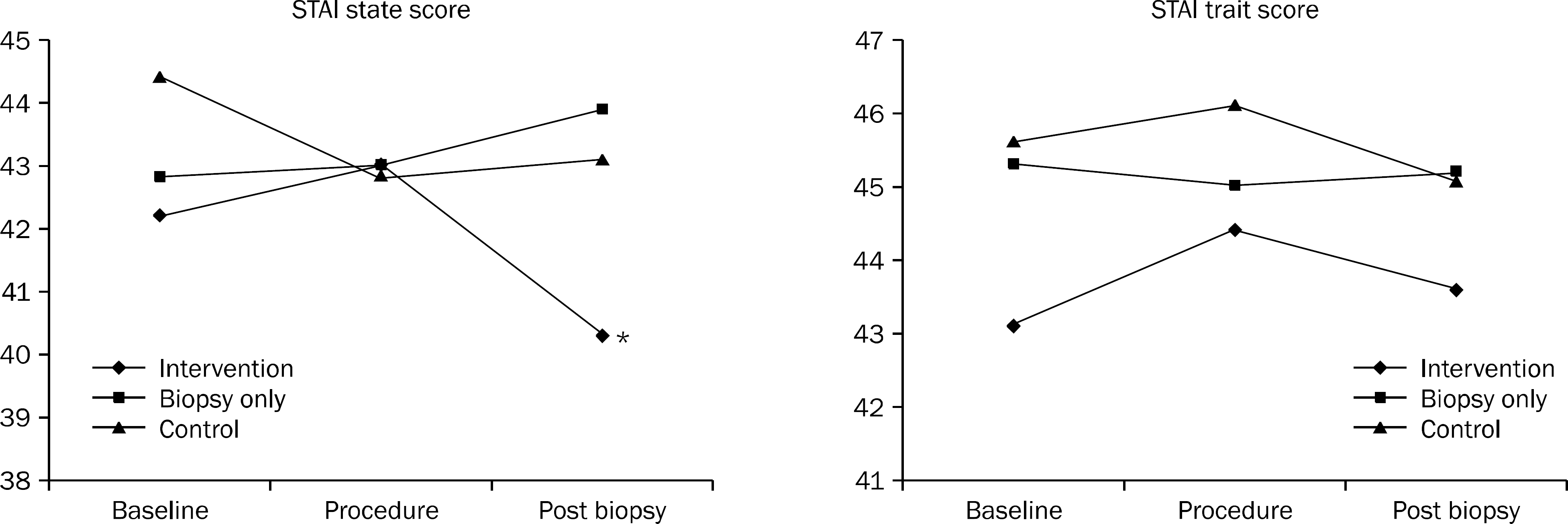Abstract
Background/Aims
Patients who undergo endoscopic biopsy suffer anxiety until results are confirmed. This study assesses the effects of written educational material on the anxiety level of patients following endoscopic biopsy.
Methods
This study was a randomized controlled study trial with 83 patients divided into the following three groups: a biopsy group given written educational material prepared by our institution following the biopsy (intervention group, n=28), a biopsy group without written material (biopsy only group, n=25), and a control group without biopsy (control group, n=30). The anxiety level of each patient was evaluated three times using Spielberger's State-Trait Anxiety Inventory (STAI): for baseline at the first visit to our institution, at the day of endoscopy, one day later, and one week after the procedure. We compared baseline characteristics, STAI scores at each visit, and differences in STAI scores among the three groups.
Results
No difference was found in STAI score among groups at baseline and before and after the endoscopic procedure. However, the STAI-state score of the intervention group was slightly lower than biopsy only group one day post-procedure (40.3±7.7 vs. 43.9±7.1, p=0.135). The STAI-state score significantly decreased from pre- to post-procedure only in the intervention group (–2.75±6.1 vs. 0.92±4.0, p<0.027).
Go to : 
References
1. Rollbusch N, Mikocka-Walus AA, Andrews JM. The experience of anxiety in colonoscopy outpatients: a mixed-method study. Gastroenterol Nurs. 2014; 37:166–175.
2. Ersöz F, Toros AB, Aydoğ an G, Bektaş H, Ozcan O, Arikan S. Assessment of anxiety levels in patients during elective upper gastrointestinal endoscopy and colonoscopy. Turk J Gastroenterol. 2010; 21:29–33.

3. Maguire D, Walsh JC, Little CL. The effect of information and behavioural training on endoscopy patients' clinical outcomes. Patient Educ Couns. 2004; 54:61–65.

4. Rudin D. Frequently overlooked and rarely listened to: music therapy in gastrointestinal endoscopic procedures. World J Gastroenterol. 2007; 13:4533.

5. Salmore RG, Nelson JP. The effect of preprocedure teaching, relaxation instruction, and music on anxiety as measured by blood pressures in an outpatient gastrointestinal endoscopy laboratory. Gastroenterol Nurs. 2000; 23:102–110.

6. Luo YY. Effects of written plus oral information vs. oral information alone on precolonoscopy anxiety. J Clin Nurs. 2013; 22:817–827.

7. Zigmond AS, Snaith RP. The hospital anxiety and depression scale. Acta Psychiatr Scand. 1983; 67:361–370.

8. Hahn DW, Lee CH, Chon KK. Korean adaptation of Spielberger's STAI (K-STAI). Korean J Health Psychol. 1996; 1:1–14.
9. Spielberger CD, Gorsuch RL, Lushene PR, Vagg PR, Jacobs AG. State-Trait anxiety inventory (Form Y). Palo Alto, CA: Mind Garden;1983.
10. Millar K, Jelicic M, Bonke B, Asbury AJ. Assessment of preoperative anxiety: comparison of measures in patients awaiting surgery for breast cancer. Br J Anaesth. 1995; 74:180–183.

11. Kain ZN, Mayes LC, Cicchetti DV, Bagnall AL, Finley JD, Hofstadter MB. The Yale Preoperative Anxiety Scale: how does it compare with a "gold standard"? Anesth Analg. 1997; 85:783–788.
12. Jones MP, Ebert CC, Sloan T, et al. Patient anxiety and elective gastrointestinal endoscopy. J Clin Gastroenterol. 2004; 38:35–40.

13. Campo R, Brullet E, Montserrat A, et al. Identification of factors that influence tolerance of upper gastrointestinal endoscopy. Eur J Gastroenterol Hepatol. 1999; 11:201–204.

14. Trevisani L, Sartori S, Putinati S, et al. Assessment of anxiety levels in patients during diagnostic endoscopy. Recenti Prog Med. 2002; 93:240–244.
15. van Zuuren FJ, Grypdonck M, Crevits E, Vande Walle C, Defloor T. The effect of an information brochure on patients undergoing gastrointestinal endoscopy: a randomized controlled study. Patient Educ Couns. 2006; 64:173–182.

16. Drossman DA, Brandt LJ, Sears C, Li Z, Nat J, Bozymski EM. A preliminary study of patients' concerns related to GI endoscopy. Am J Gastroenterol. 1996; 91:287–291.
17. Morgan J, Roufeil L, Kaushik S, Bassett M. Influence of coping style and precolonoscopy information on pain and anxiety of colonoscopy. Gastrointest Endosc. 1998; 48:119–127.

18. Aabakken L, Baasland I, Lygren I, Osnes M. Development and evaluation of written patient information for endoscopic procedures. Endoscopy. 1997; 29:23–26.

19. Callaghan P, Chan HC. The effect of videotaped or written information on Chinese gastroscopy patients' clinical outcomes. Patient Educ Couns. 2001; 42:225–230.

20. Bytzer P, Lindeberg B. Impact of an information video before colonoscopy on patient satisfaction and anxiety: a randomized trial. Endoscopy. 2007; 39:710–714.
Go to : 
 | Supplementary Fig. 1.The written educational material for endoscopic biopsy in our study (Korean version). |
 | Supplementary Fig. 2.The written educational material for endoscopic biopsy in our study (English version). |
 | Fig. 1.Flow chart of the study design. Enrolled patients were measured Spielberger's State-Trait Anxiety Inventory (STAI; state, trait) at reservation day for endoscopy, procedure day and follow up day. Only intervention group patients were provided written educational materials after endoscopic biopsy. OPD, outpatient department. |
 | Fig. 2.Comparison of mean state and trait anxiety levels after using of written educational material. *The Spielberger's State-Trait Anxiety Inventory (STAI)-state score was significantly decreased in the intervention group (control, biopsy only, and intervention group; 0.29±5.3,0.92±4.0, and –2.75±6.1, respectively; p=0.029). |
Table 1.
Demographic Characteristics by Group
| Variable | Control (n=30) | Biopsy only (n=25) | Intervention (n=28) | p-value |
|---|---|---|---|---|
| Age (yr) | 44.0±12.0 | 47.4±13.6 | 51.1±13.8 | 0.131 |
| Gender | 0.814 | |||
| Male | 12 (40.0) | 12 (48.0) | 13 (46.4) | |
| Female | 18 (60.0) | 13 (52.0) | 15 (53.6) | |
| Educational level | 0.762 | |||
| Primary school graduate | 1 (3.3) | 2 (8.0) | 2 (7.1) | |
| High school graduate | 5 (16.7) | 5 (20.0) | 5 (17.9) | |
| University graduate | 21 (70.0) | 14 (56.0) | 20 (71.4) | |
| Not checked | 3 (10.0) | 4 (16.0) | 1 (3.6) | |
| Existing conditions | 0.223 | |||
| None | 24 (80.0) | 10 (40.0) | 18 (64.3) | |
| Diabetes mellitus | 0 (0.0) | 1 (4.0) | 1 (3.6) | |
| Hypertension | 2 (6.7) | 3 (12.0) | 2 (7.1) | |
| Thyroid disease | 0 (0.0) | 2 (8.0) | 1 (3.6) | |
| Gastric ulcer | 0 (0.0) | 0 (0.0) | 2 (7.1) | |
| Duodenal ulcer | 0 (0.0) | 1 (4.0) | 1 (3.6) | |
| Gastric cancer | 0 (0.0) | 1 (4.0) | 0 (0.0) | |
| Liver disease | 1 (3.3) | 1 (4.0) | 0 (0.0) | |
| Others | 3 (10.0) | 6 (24.0) | 4 (14.3) | |
| Endoscopy history | 0.451 | |||
| Done | 18 (60.0) | 19 (76.0) | 19 (67.9) | |
| Not done | 12 (40.0) | 6 (24.0) | 9 (32.1) | |
| Current endoscopy | 0.375 | |||
| Gastroscopy | 9 (30.0) | 7 (28.0) | 3 (10.7) | |
| Colonoscopy | 8 (26.7) | 5 (20.0) | 7 (25.0) | |
| Gastroscopy and colonoscopy | 13 (43.3) | 13 (52.0) | 18 (64.3) | |
| Type of biopsy a | 0.394 | |||
| Gastroscopy | 7 (28.0) | 6 (21.4) | ||
| Colonoscopy | − | 5 (20.0) | 14 (50.0) | |
| Gastroscopy and colonoscopy | 13 (52.0) | 8 (28.6) |
Table 2.
State and Trait Anxiety Scores at Baseline, prior to Gastroscopy and Colonoscopy, and One Day Post-procedure by Group
Table 3.
Number of Patients with High State Anxiety Scores at Baseline, prior to Gastroscopy and Colonoscopy, and One Day Post-procedure by Group
Table 4.
Comparisons of Differential in STAI Scores between Pre- and Post-procedure by Group
| Control (n=30) | Biopsy only (n=25) | Intervention (n=28) | p-value | |
|---|---|---|---|---|
| STAI (state anxiety) a | 0.29±5.3 | 0.92±4.0 | −2.75±6.1 | 0.029 |
| STAI (trait anxiety) | −1.06±7.2 | 0.25±3.8 | −0.71±5.2 | 0.707 |




 PDF
PDF ePub
ePub Citation
Citation Print
Print


 XML Download
XML Download